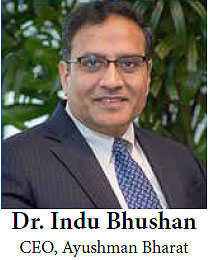

To eliminate the incidence of impoverishment due to catastrophic expenditure on health by providing financial protection to poor and vulnerable groups covering up to Rs. 500,000 per family per year, Government’s flag ship scheme Ayushman Bharat PMJAY was launched to cover medical and hospitalization expenses for almost all secondary care and most of tertiary care procedures.
While main purpose of the scheme is to provide financial protection, it will also improve the quality and availability of services in aspirational districts and tier-2 and tier-3 cities. CEO Ayushman Bharat PMJAY Dr Indu Bhushan in an interview with Healthy India Chronicle gives a low down about the progress of the scheme.
1.What is Ayushman Bharat vision for public health towards healthy India. What is the action plan forward.
Health sector in India continues to be characterized by high out-of-pocket (OOP) expenditure, low financial protection, low health insurance coverage amongst both rural and urban population. This often forces people to incur catastrophic expenditure on health care. More than 60% of health expenditure is paid out of pocket. Hospitalization expenses are not covered through any form of health protection. According to one estimate, each year 6 crore people are pushed below the poverty line as they meet their healthcare needs by spending large a proportion of their income and savings, borrowing money or selling their productive assets.
The current chronic morbidity rate for poorest 40% is about 4% whereas the hospitalisation rate is 2.45%. Compared to this, the richest 40% have the slightly lower morbidity but a hospitalisation rate of 5.15%. This large gap in hospitalisation for the poor is because of lack of affordability, knowledge and access to services.
PM-JAY has defined 1,350 medical packages covering surgery, medical and day care treatments including medicines, diagnostics and transport.
PM-JAY seeks to accelerate India’s progress towards achievement of Universal Health Coverage (UHC) and Sustainable Development Goal – 3 (SDG3).
2.How is it catering to the rural India which has 7 lakh villages.
PM-JAY currently targets 10.74 crore beneficiaries and out of which 8.41 crore beneficiary families are in rural areas. So PM-JAY has strong focus on covering the rural beneficiary families.
32 States/UTs have joined the scheme and implementing it across 631 districts. The remaining states are likely to join soon.
3. How is it going to bridge the gap between the rural and urban India with the current empaneled hospitals. What is the way forward.
Currently private hospitals in India are concentrated in urban areas. One of the main reasons for this inequitable distribution of services is the lack of paying capacity in rural areas. Private hospitals do not find it financially viable to operate in rural areas. But AB-PMJAY is improving the paying capacity of the poor in rural areas. With the increased paying capacity, we hope new private hospitals will open in the locations which are closer to the beneficiaries. This will bridge the gap between rural and urban India in the medium term.
PM-JAY has empanelled more than 15,000 hospitals and they are in both rural and urban areas. The empanelment criteria under the scheme has been kept in such a way so as to incentivise hospitals in aspirational districts. These hospitals receive 10% greater compensation as compared to others.
4. What is the budget allocation and resource allocation for rural India vis-a-vis the urban India. How many beneficiaries have been served and amount utilised under the Ayushman Bharat programme in rural and urban areas.
AB PM JAY, being centrally sponsored scheme is fully funded from the consolidated fund of India and the budget allocated is received from Government of India as recurring grant-in-aid. The budget allocation for the fiscal year 2019-20 is Rs. 6400 Crore.
The expenditure under AB – PM JAY is shared between Central Government and State Government / Union Tertiary as per the sharing instructions issued by Ministry of Finance. The existing sharing ratio is as under:
- For North Eastern and 3 Himalayan States: 90 (CG): 10 (SG)
- For Union Territories with Legislation and Other States: 60 (CG): 40 (SG)
- For Union Territories without Legislation: 100 (CG)
So far, more than 25 lakh beneficiaries have received treatment under the scheme. Majority of these beneficiaries are from rural areas.
5. What is the monitoring mechanism to track the programme outcome considering the fact that we need to empower the healthcare at the grassroots level. How do you foresee the programme outcome considering its current implementation.
A strong and robust monitoring mechanism has been set up under the scheme. Real time dashboards have been prepared which are available at all levels. Various performance parameters have been identified and scheme’s performance is measured regularly on those parameters. These dashboards can drill down to district levels and help States monitor their performance district wise.
For such indicators that are not available from routine data, household surveys and hospital surveys are being done to monitor the impact of the scheme. We are also undertaking several studies to assess the impact of the scheme in partnership with think tanks and academic institutions across the country.
6. How far has the empaneled hospitals been able to cater to the beneficiaries which currently stands at 18 lakh according to government estimates.
As per our latest data from the National Health Authority, the current number of verified beneficiaries is 3.3 crores and more than 25 lakh beneficiaries have been treated under AB-PMJAY till yesterday.
7. What is the policy for disabled people and action plan to help the 3 crore disabled people in the country.
The scheme do not discriminate based on disability and therefore all the eligible disabled persons are automatically covered under the scheme. Since there is no requirement of a prior enrolment process, it is easier for disabled persons to directly go to hospital for treatment.
8. What is the criteria to empanel hospitals and how many hospitals have been able to fulfill the criteria and meet the desired outcomes.
To build an effective and accountable network of providers, a set of minimum criteria has been developed, based on which hospitals have been (are being) empanelled. Quality, patient safety and appropriateness of care are the core principles around which the AB-PMJAY empanelment criteria and process have been created in order to drive genuine improvements in care delivery and eventually for improved health outcomes for beneficiaries. The criteria established under the Clinical Establishment Act , has been used as a guiding example to establish structural & human resource requirements for specialities based on the intensity of care required.
All establishments with indoor admission facility are eligible to be empanelled under PMJAY, provided they can meet the basic requirements. Both Public and Private healthcare providers which provide hospitalization and/or day care services are eligible for empanelment under PMJAY, subject to their meeting of certain requirements in the areas of infrastructure, manpower, equipment (IT, help desk etc.) and services (for e.g. liaison officers to facilitate beneficiary management) offered.
All public facilities (including ESI) with capability of providing inpatient services (Community Health Centre level and above) are deemed empanelled to contribute actively under PMJAY. For private providers a tiered approach to empanelment is followed.
State Governments have the flexibility to revise the empanelment criteria based on their local context, availability of providers, and the need to balance quality and access.
9. How many empaneled hospitals are likely to join in the programme.
So far 15,109 hospitals, public and private, of various capacities across the country have been empanelled. Out of these, nearly half are private hospitals that are providing 64% of the treatment under PM-JAY.
All 15,109 empaneled hospitals are implementing the scheme. We have designed and put in place a performance-linked payment system to incentivize them to continuously improve quality and patient safety, based on successive milestones. Hospitals qualifying for NABH entry-level accreditation will receive an additional 10%, while those qualifying for full accreditation will receive an additional 15%. To promote equity in access, hospitals providing services in aspirational districts will receive an additional 10%.
10. How is Ayushman Bharat scheme going to be integrated with the state health programmes in the country. So far how many states have been brought under the fold and which will be taken first.
Ayushman Bharat PM-JAY has been able to converge with various State Government funded health insurance/ assurance schemes. Out of 36 States/ UTs, 32 have signed MoU with National Health Authority for implementing PM-JAY and most of these States have started implementation of the scheme. Discussions are in progress with rest of the States to bring them on board.
11. What are your plans for North East and hilly states like J&K, Himachal Pradesh and Uttarakhand in terms of giving them special consideration under the Ayushman Bharat scheme.
Special provisions have been created for these states in terms of the financing of the scheme. For North Eastern and three Himalayan States, the 90 percent of the expenditure is borne by the central government and remaining 10 percent by the state government. For Union Territories without legislation, the central government pays the entirety of the cost.
12. How is Ayushman Bharat going to percolate to grassroots considering the vast population in urgent need of affordable healthcare.
Reaching out to 10 crore families spread across the country out of which more than 8 crore are in the rural areas is definitely one of the most important areas of opportunity as well as challenge for us. One of the ways, we are doing this is by making use of mass media (radio and TV) and outdoor advertising to create awareness about the scheme among the rural populace. We have a 24×7 toll-free helpline 14555 to take all queries related to eligibility, assistance in searching for nearest empanelled hospitals, and all detail about the scheme.
Apart from this, we have partnered with Common Service Centres (CSC) under the Ministry of Electronics and Information Technology (MEITY) to utilize the last mile network of 2,70,000 CSCs spread across rural and semi-urban areas to verify beneficiaries’ eligibility under the Ayushman Bharat PMJAY and provide advocacy for the scheme and promote it among citizens to increase scheme’s uptake among needy families. Through their network of 2 lakh village level entrepreneurs, the CSCs have been actively holding camps to generate PMJAY e-cards for village residents across 17 states. VLEs have also been visiting people’s homes in door-to-door awareness campaigns, issuing them their eligibility cards. So far more than 2.5 crore e-cards (out of total 3.3 crore e-cards) have been generated through the CSCs.
As mentioned earlier, we have designed and put in place a performance-linked payment system to incentivize hospitals to continuously improve quality and patient safety, based on successive milestones. Hospitals qualifying for NABH entry-level accreditation will receive an additional 10%, while those qualifying for full accreditation will receive an additional 15%. To promote equity in access, hospitals providing services in aspirational districts will receive an additional 10%.
With greater collective purchasing and bargaining power of 500 million people through PMJAY, the ongoing epidemiological transition to non-communicable diseases and aging of population, the demand for secondary and tertiary care will continue to increase. We will need to increase the reach, efficacy and quality of healthcare service delivery manifold in order to feed this growing demand, especially in small towns and rural areas where supply of providers is low. Augmenting individual and collective capacities and efficiencies of driving PM-JAY will be complemented with healthcare innovation and greater private investment in healthcare and frontier technologies. We hope that technologies like tele-medicine and artificial intelligence will help in expanding our reach to rural areas and service-deficit regions.


























